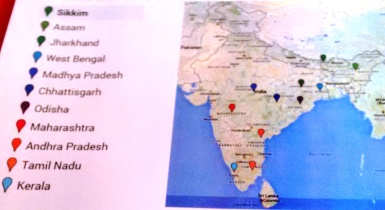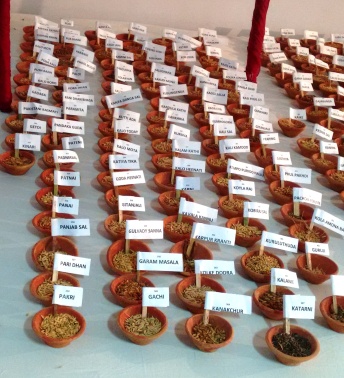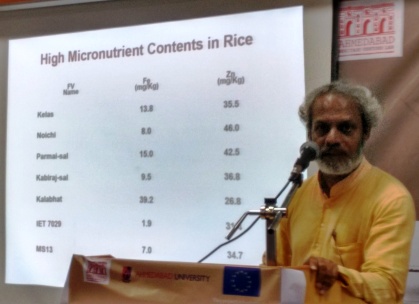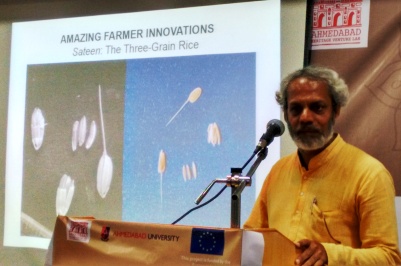An Article based on: Expert Talk by Dr Debal Deb and my thoughts interweaved:
Akshat Mohatsav – a unique Rice heritage exhibition | Ahmedabad | 16-17 April 2016
original article by Ms Chinmai Hemani appeared here
____
Akshat Mohatsav – was a unique Rice heritage exhibition held at Ahmedabad on 16-17th April, 2016. This unique rice heritage exhibition showcased 1800 varieties of traditional rice varieties from 11 states ( Sikkim, Assam, Jharkhand, West Bengal, MadhyaPradesh, Chhattisgarh,  Odisha, Maharashtra, Andhra Pradesh, Tamil Nadu, Kerala) of India.
Odisha, Maharashtra, Andhra Pradesh, Tamil Nadu, Kerala) of India.
 Odisha, Maharashtra, Andhra Pradesh, Tamil Nadu, Kerala) of India.
Odisha, Maharashtra, Andhra Pradesh, Tamil Nadu, Kerala) of India.
One may think, why was there a need to have an exhibition on rice?
Rice is the most important crop to millions of small farmers and farm labourers who grow it on millions of hectares throughout India and derive income from working on these farms. In order to tackle the increasing population, decreasing land under cultivation and climatic changes, it is imperative that rice production grow at least as rapidly as the population growth.
This unique rice exhibition by exhibiting 1800 varieties of rice and sale of 40 different varieties collected through various states of India sought to share and collectively celebrate and conserve our precious bio-cultural heritage with people from various walks of life. It was an effort to show our reverence to farmers and conservationists who are working to preserve our fast disappearing heritage.
Dr Debal Deb an eminent ecologist and Rice conservationist (a Fulbright scholar having post-doctoral ecology work at the University of California at Berkeley) was the key note speaker at this occasion who spoke on the importance of our traditional varieties of crops to tackle climate change.
I was privileged to be a team member contributing my skills and ideas at this unique exhibition held in India. Here is an article based on the talk of Dr Deb at this occasion.
____
India 50 years ago had over 110,000 landraces (local varieties) of rice but today there are  just 7,000 of these folk varieties left, with fewer of them being grown every year!! I was shocked and intrigued both at the same time learning this fact while hearing Dr Debal Deb speak in his talk at Akshat Mohatsav . He mentions that rest of around 1, 00,000 varieties are no longer cultivated and the knowledge of how to grow them lost.
just 7,000 of these folk varieties left, with fewer of them being grown every year!! I was shocked and intrigued both at the same time learning this fact while hearing Dr Debal Deb speak in his talk at Akshat Mohatsav . He mentions that rest of around 1, 00,000 varieties are no longer cultivated and the knowledge of how to grow them lost.
 just 7,000 of these folk varieties left, with fewer of them being grown every year!! I was shocked and intrigued both at the same time learning this fact while hearing Dr Debal Deb speak in his talk at Akshat Mohatsav . He mentions that rest of around 1, 00,000 varieties are no longer cultivated and the knowledge of how to grow them lost.
just 7,000 of these folk varieties left, with fewer of them being grown every year!! I was shocked and intrigued both at the same time learning this fact while hearing Dr Debal Deb speak in his talk at Akshat Mohatsav . He mentions that rest of around 1, 00,000 varieties are no longer cultivated and the knowledge of how to grow them lost.
Dr Deb opines that industrial agriculture has led farmers to become entirely dependent on commercial seed suppliers for their crop and thus has led to mass extinction of our traditional / heritage varieties of crops. Traditionally seeds used to be a precious gift to relatives and friends as crop seeds belonged to the community, thus there was no scope for commercial appropriation. He further adds that it took over 12000 years since rice was domesticated to develop over 1,10,000 varieties of rice but it has taken mere 30 years of green revolution to destroy and reduce them to just about 7000 which has led to the loss of genetic diversity and rich biodiversity. It is an ecological and cultural disaster for which we are paying now. Most of these varieties are still found and preserved in the North eastern states due to still lesser penetration of ‘developmental’ agenda as compared to main land India which barely has 2000 varieties conserved now!
Over millennia’s human interaction with nature has helped develop an incredible range of cultivated diversity of crops. The rich Bio-cultural heritage which our ancestors have developed and cherished was a result when bio-diversity of our land was clubbed with each regions socio-cultural practice, which we are on the verge of losing . Dr Deb suggests that it is this complexity of ecological system which is the key to resiliency unlike monoculture practices suggested by modern agriculture. On questioning Dr Deb as what was meant by ‘tradition’ he mentions characteristics that define tradition as: one that is passed on through oral transmission and second as learning that was passed on through generations. So in terms of tradition of conserving our bio-cultural heritage, it was farmers and tribals who nurtured and protected these rich seed diversities. But with advent of industrial revolution and later the green revolution our course of path of human development has drastically changed which is one of the leading causes that has led to several challenges, alienations and a rapid erosion of such bio-cultural heritage and associated practices.
Local varieties as strategy to address agricultural woes engraved by climate change, semantic imperialism and agro-politics
Dr Deb mentions that these farmer scientists the “unnamed, unknown, and greatly talented scientists of the past” were as such ‘illiterate’ but were the creators of varieties of rice interweaving culture and agro-biodiversity. Through artificial and conscious selective breeding these farmer scientists developed most of the crops like which land to grow, intercropping which crops, what would be the osmotic stress tolerance (salinity / drought / flood) etc all through their empirical learning’s. Interestingly Dr Deb mentioned that Darwin put out a parallel theory of evolution by natural selection which suggests that it is natural selection that acts to preserve and accumulate minor advantageous genetic mutations!!
It was these unnamed unknown farmer scientists who developed rice varieties which could withstand a drought or flood or sea water. Yet these farmer scientists are not revered for this rich knowledge they own. He calls this as semantic imperialism, where traditional knowledge is sidelined and termed as ‘alternative’ by the modern ‘scientific’ knowledge when all the while traditional knowledge was main stream form of knowledge till the modern science impinged upon the traditional knowledge holders. Agro-politics has also played its part! Today we are confusing science and technology – what we are doing with machines is part of using technology and not developing any science. Even an ‘illiterate’ rural women would know what to apply and not apply if the cloth was stained with turmeric to remove its stains, which is also science! They didn’t go to schools to learn that science by learnt empirically.
Dr Deb is not at all impressed by GM science or hybrid rice growing and mentions that companies are spending billions of dollars on ‘gene mining’ (seeking specific genes ). Yet after 60 years they still do not have one which can tolerate drought, flood, and salinity or even grow on single event of rain fall with no drop of water later for irrigation, ones which can grow in 12 ft deep water, all of which are available in these local land races. Thus it is these land races / heritage varieties which not just anchor cultural and genetic biodiversity but also provide food security as well while outperforming modern cultivars in marginal environmental conditions. Thus they hold great importance in these times of climate change when we face extreme flooding, extreme droughts, temperature rise, salinity ingress etc.
Local varieties and micro-nutrients
These traditional varieties have been found to have exceptional nutraceutical [i](Nutritional + pharmaceutical) values. Did you know a rice variety named Garib sal – which is capable of absorbing silver from soil? Dr Deb’s scientific study of Garib sal led to incidental discovery of silver as high as 15.6ppm in each grain (15.6 mg/kg) of Garib sal while trying to figure out heavy metals like iron and zinc. Silver is stored in its embryo and not shed out thus indicating silver’s biological significance for the plant. Dr Deb and his team of 3 members since last 11 months have done various tests and it has proved that silver absorbing properties of this rice variety doesn’t change!
He mentions that no other plant has been studied so far which is known to assimilate silver from soil unlike Garib sal which was once grown in West Bengal and was recommended as diet to treat gastric infections. Now the modern science proves that silver in nano quantities kills bacteria’s and pathogenic microbes in human gut but such medicinal property was exploited and consumed by our ancestors already through their empirical knowledge! How did we lose it thinking that it was traditional and what was mentioned as superstition?? Many of our traditions had superstitions embedded but as rational thinkers we need to segregate what is superstition and what is not before discarding the knowledge all together Dr Deb suggests.
 Certain varieties like Kelas has iron 13.8 mg / kg and zinc 35.5 mg/kg, Noichi has 8.0, 46 mg/ kg, Paramai-sal has 15, 42.5 mg/kg, Kabiraj-sal has 9.5, 36.8mg/kg, Kalabhat 39.2, 26.8 mg/kg respectively are used to treat women facing anemia during pregnancy due to presence of high iron content. Kabiraj has also property of breaking starch into amino acids and protein. Thus it is used in treating patients having intolerance to animal protein. Badshah–sal has iron content as high as 138mg/kg. However Monsanto’s modern scientifically evolved MS13 variety of rice has just 7 mg/kg iron and 34.7 mg/kg of zinc after spending 2 billion dollars to develop it, while IET7029 has 1.9 and 31.9 mg/kg of iron and zinc and yet suggested as improved varieties for accelerating development and tacking malnutrition!! He further suggests that there are varieties which have anti-oxidant properties and omega 3 and are useful to treat cancer.
Certain varieties like Kelas has iron 13.8 mg / kg and zinc 35.5 mg/kg, Noichi has 8.0, 46 mg/ kg, Paramai-sal has 15, 42.5 mg/kg, Kabiraj-sal has 9.5, 36.8mg/kg, Kalabhat 39.2, 26.8 mg/kg respectively are used to treat women facing anemia during pregnancy due to presence of high iron content. Kabiraj has also property of breaking starch into amino acids and protein. Thus it is used in treating patients having intolerance to animal protein. Badshah–sal has iron content as high as 138mg/kg. However Monsanto’s modern scientifically evolved MS13 variety of rice has just 7 mg/kg iron and 34.7 mg/kg of zinc after spending 2 billion dollars to develop it, while IET7029 has 1.9 and 31.9 mg/kg of iron and zinc and yet suggested as improved varieties for accelerating development and tacking malnutrition!! He further suggests that there are varieties which have anti-oxidant properties and omega 3 and are useful to treat cancer.
Can we not see the difference? As logical and rational citizens which one will we chose as better variety with higher micronutrients? Do we not see agro-politics here?
 And then how could we forget other farmer innovations of creating rice variety named Jugal which have two rice grains in one kernel and Sateen a three grained rice in one kernel!! Isn’t it a fantastic strategy for more crop per kernel, More crop per sq ft! How is it we thought of abandoning such ingenious varieties?? Wouldn’t these crops fit into climate change adaptation strategies?
And then how could we forget other farmer innovations of creating rice variety named Jugal which have two rice grains in one kernel and Sateen a three grained rice in one kernel!! Isn’t it a fantastic strategy for more crop per kernel, More crop per sq ft! How is it we thought of abandoning such ingenious varieties?? Wouldn’t these crops fit into climate change adaptation strategies?
Dr Deb also stressed that our traditional millets like pearl millet has iron content as high as 16.9 mg/ kg, Barnyard millet 15.2 mg/kg, little millet 9.3 mg/kg, Foxtail millet 2.8 mg/kg. These were the crops which provided micronutrients to the poor but now have been taken over by monoculture of wheat due to its higher linkage to GDP inspite of the food security it provides.
While traditional varieties are mainly rain-fed and developed over the local region and climatic condition with complex eco-system unlike monoculture crops would not need any additional pesticide and fertilizer inputs. For e.g. a hybrid variety of wheat would require 22000 kg joules to produce one kg of wheat considering the energy needed for pesticide, fertilizer, irrigated water etc where as rain fed crop of wheat would only need 1200 kg joule / kg of wheat. So though agriculture crop yield may seem more for hybrid, the cost and water effectiveness of traditional crops is higher than hybrid ones. More over the hybrid seeds would have to be purchased by farmers’ year on year for next year’s harvest from seed corporations ( where corporations gain enormously from farmers ) unlike traditional ones which farmers preserve in their seed bank for their next years harvest giving yields thus making farmers into monoculture and hybrid cropping incur additional costs every year unlike traditional crops.
He suggests that it is sad state that in our country there is no policy to make it possible to grow, promote and market such traditional varieties. But as conscious citizens we can make choices of what to buy and support.
Dr Deb and his conservation efforts
Dr Deb has been working with over 14000 farmers in over 12 states of India. He is also a founder of India’s largest non-governmental folk rice gene bank that conserves 1120 traditional rice varieties named Virhi ( meaning ‘rice’ in Sanskrit). He started this in situ seed conservation in 1996 with extensive germplasm collection expeditions across 11 states of India. He also has a 2 acre research farm named ‘Basudha’ in Odisha which demonstrates ecological architecture, eco-forestry, and alternative energy use. To maintain the genetic purity of each of these growing heirloom varieties in the same land area of his farm and to prevent cross–pollination, year on year, necessitates an intricate sowing plan which was experimented by Dr Deb and his colleagues, such that no two neighbouring varieties flower at the same time. Such ingenious devise of temporal spacing of varieties is used for guarding against cross-pollination. Dr Deb published his methodology in the Current Science journal in July 2006, after field-testing it for six years and is recognized by FAO.
In his repository gene bank, he has over 152 varieties which are aromatic, 2 varieties which can grow in 12 feet deep water, 11 varieties that can grow in salinity affected areas from 6 states of India, 16 varieties that are drought tolerant, around 20 varieties that can grow in 4-5 feet water and 6 varieties which after first rainfall doesn’t need a drop of water. He is the sole owner and last repository of around 400 varieties of rice! Did we lose our tradition and culture? Can our agriculture minister not take a note of these traditional varieties which can be a boon to tackle climatic changes of extreme floods, droughts and salinity ingress??
What you can do – If you are a farmer to conserve this rich rice heritage?
Dr Debal Deb, each year after the year’s harvest distributes genetically pure seeds free of cost to any and all indigenous farmers in need from his seed bank – Virhi. (Vidal, 2014) in his article mentions that Dr Deb grows these rice varieties and then distributes it in 1kg packets. “Farmers take the seeds on condition they bring some back. They must return 2kg as proof they have cultivated it. Most give 1kg to other farmers so the cycle continues. In three years in Orissa, 2,000 farmers have received the seeds and 350 varieties have been distributed.” He also provides training to farmers in ecological agriculture.
What you can do – If you are not a farmer to conserve this rich rice legacy?
Conserve India’s incredibly rich diversity of rice and bio-cultural heritage by opting many of the following:
- Support farmers growing organic and traditional by procuring and switching to local traditional varieties
- Show reverence to the farmers growing traditional rice varieties
- Learn more of these varieties its nutritional and medicinal properties
- Cherish traditional local rice recipes by learning them and preparing them
- Participate actively in expert talks | workshops | panels on rice biodiversity and current issues
- Spread message to the farmers you know, who could avail the deep knowledge that Dr Debal Deb has and obtain appropriate seeds which are climate sensitive to the region the farmer belongs.
- Participate in farming activities
To sum up I feel, there needs to be both bottom up approach – where every individual like you and me as responsible citizens understand the importance of traditional crops and its vital linkages of addressing climate change issues and issues of food security and where we could contribute to share this knowledge of rich rice heritage to our peers, family, learn more about our losing rice heritage legacy and its drivers leading to extinction and be the change agents to adopt buying these rice varieties in turn supporting incredibly hardworking farmers who have preserved this rich legacy so far and fighting against the market forces.As consumers we have power to influence market by opting what we choose to buy. This has to also be clubbed with the top bottom approach where government introduces policies to support traditional crops. Many states have come up with organic farming policy where they can also bring in policy to support growing such traditional crops, bring in market mechanism where such crops can compete in the market where only cash crops rule currently.
Hope still remains as there are numerous farmers and communities existing even today who are engaged in conserving these irreplaceable rice varieties even as they practice organic ecological farming. Our food, nutrition, health and even ecological and climate security depends on it. Thus it is important and of immense value to rediscover and share this biodiversity with its food and cultural dimensions to the community at large.
It was indeed a humbling experience and treat to hear Dr Deb talk of his experiences and scientific research on various crops apart from rice and also how these very traditional crops may not seem beneficial to bring in money and increase GDP to our agronomists and policy makers but is so crucial to address food security issues that climate change will bring. As an ecological economist that Dr Deb is our talks post the lecture did go on whether economical value to natural resource would help conserve the natural resources and why it is a mechanism to failure for preserving and how in Indian culture we had infinite value to natural resources inherently embedded in our beliefs and practices. Most of which I could understand but fail to grasp totally to reproduce it here.
Dr Deb can be reached on cintdis@hotmail.com for further interaction.
___
Footnote:
[i] According to IRRI website rice provides 21% of global human per capita energy and 15% of per capita protein. Although rice protein ranks high in nutritional quality among cereals, protein content is modest. Rice also provides minerals, vitamins, and fiber, although all constituents except carbohydrates are reduced by milling. (IRRI, 2016)
Thus the importance of hand milled varieties as they retain the minerals, vitamins and fiber far more than the machine milled crops. Apart from giving employment to many poor people as a means of livelihood option of hand milling ( in spite of this livelihood option of being tagged by modernists / industrialists / politicians as labour intensive while giving technological solutions to remove labour, it is by far the best way to retain micronutrients. So while buying traditional varieties one of the indicators apart from just checking nutrient value is to ask for hand milled varieties as well.)





